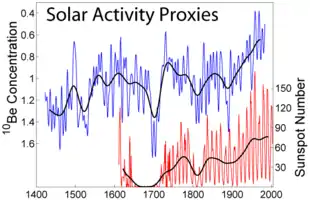Beryllium-10
Beryllium-10 (10Be) is a radioactive isotope of beryllium. It is formed in the Earth's atmosphere mainly by cosmic ray spallation of nitrogen and oxygen.[3][4][5] Beryllium-10 has a half-life of 1.39 × 106 years,[6][7] and decays by beta decay to stable boron-10 with a maximum energy of 556.2 keV. It decays through the reaction 10Be→10B + e−. Light elements in the atmosphere react with high energy galactic cosmic ray particles. The spallation of the reaction products is the source of 10Be (t, u particles like n or p):
- 14N(t,5u)10Be; Example: 14N(n,p α)10Be
- 16O(t,7u)10Be

| General | |
|---|---|
| Symbol | 10Be |
| Names | beryllium-10, Be-10 |
| Protons | 4 |
| Neutrons | 6 |
| Nuclide data | |
| Natural abundance | trace |
| Half-life | 1.39×106 y |
| Spin | 0+ |
| Binding energy | 6497.6318 keV |
| Decay modes | |
| Decay mode | Decay energy (MeV) |
| β− | 0.5560[1][2] |
| Isotopes of beryllium Complete table of nuclides | |
Because beryllium tends to exist in solutions below about pH 5.5 (and rainwater above many industrialized areas can have a pH less than 5), it will dissolve and be transported to the Earth's surface via rainwater. As the precipitation quickly becomes more alkaline, beryllium drops out of solution. Cosmogenic 10Be thereby accumulates at the soil surface, where its relatively long half-life (1.387 million years) permits a long residence time before decaying to 10B.
10Be and its daughter product have been used to examine soil erosion, soil formation from regolith, the development of lateritic soils and the age of ice cores.[8] It is also formed in nuclear explosions by a reaction of fast neutrons with 13C in the carbon dioxide in air, and is one of the historical indicators of past activity at nuclear test sites.
See also
| Lighter: Beryllium-9 |
Beryllium-10 is an isotope of beryllium |
Heavier: Beryllium-11 |
| Decay product of: lithium-11 (β−, n) |
Decay chain of beryllium-10 |
Decays to: boron-10 |
References
- "Decay Radiation: 10Be". National Nuclear Data Center. Brookhaven National Laboratory. Retrieved 2013-10-16.
- Tilley, D.R.; Kelley, J.H.; Godwin, J.L.; Millener, D.J.; Purcell, J.E.; Sheu, C.G.; Weller, H.R. (2004). "Energy levels of light nuclei". Nuclear Physics A. 745 (3–4): 155–362. doi:10.1016/j.nuclphysa.2004.09.059.
- G.A. Kovaltsov; I.G. Usoskin (2010). "A new 3D numerical model of cosmogenic nuclide 10Be production in the atmosphere". Earth Planet. Sci. Lett. 291 (1–4): 182–199. Bibcode:2010E&PSL.291..182K. doi:10.1016/j.epsl.2010.01.011.
- J. Beer; K. McCracken; R. von Steiger (2012). Cosmogenic radionuclides: theory and applications in the terrestrial and space environments. Physics of Earth and Space Environments, Springer, Berlin. Physics of Earth and Space Environments. 26. doi:10.1007/978-3-642-14651-0. ISBN 978-3-642-14650-3. S2CID 55739885.
- S.V. Poluianov; G.A. Kovaltsov; A.L. Mishev; I.G. Usoskin (2016). "Production of cosmogenic isotopes 7Be, 10Be, 14C, 22Na, and 36Cl in the atmosphere: Altitudinal profiles of yield functions". J. Geophys. Res. Atmospheres. 121 (13): 8125–8136. arXiv:1606.05899. Bibcode:2016JGRD..121.8125P. doi:10.1002/2016JD025034. S2CID 119301845.
- G. Korschinek; A. Bergmaier; T. Faestermann; U. C. Gerstmann (2010). "A new value for the half-life of 10Be by Heavy-Ion Elastic Recoil Detection and liquid scintillation counting". Nuclear Instruments and Methods in Physics Research Section B: Beam Interactions with Materials and Atoms. 268 (2): 187–191. Bibcode:2010NIMPB.268..187K. doi:10.1016/j.nimb.2009.09.020.
- J. Chmeleff; F. von Blanckenburg; K. Kossert; D. Jakob (2010). "Determination of the 10Be half-life by multicollector ICP-MS and liquid scintillation counting". Nuclear Instruments and Methods in Physics Research Section B: Beam Interactions with Materials and Atoms. 268 (2): 192–199. Bibcode:2010NIMPB.268..192C. doi:10.1016/j.nimb.2009.09.012.
- Balco, Greg; Shuster, David L. (2009). "26Al-10Be–21Ne burial dating" (PDF). Earth and Planetary Science Letters. 286 (3–4): 570–575. Bibcode:2009E&PSL.286..570B. doi:10.1016/j.epsl.2009.07.025.